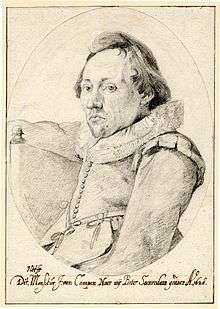Pieter Jansz. Saenredam
| Pieter Jansz. Saenredam | |
|---|---|
 Pieter Saenredam in 1628 by Jacob van Campen | |
| Born |
9 June 1597 Assendelft |
| Died |
31 May 1664 (aged 66) Haarlem |
| Nationality | Dutch |
| Parent(s) | Jan Pietersz Saenredam |



Pieter Jansz. Saenredam (9 June 1597 - buried 31 May 1665) was a painter of the Dutch Golden Age, known for his distinctive paintings of whitewashed church interiors.
Biography
Saenredam was born in Assendelft, the son of the Northern Mannerist printmaker and draughtsman Jan Pietersz Saenredam whose sensuous naked goddesses are in great contrast with the work of his son. In 1612 Saenredam moved permanently to Haarlem, where he became a pupil of Frans de Grebber. In 1614 he became a member of the Haarlem Guild of St. Luke.[1] A painting in the British Museum by his friend Jacob Van Campen shows him to be very short and hunch backed.[2] He died in Haarlem.
He was a contemporary of the painter-architects Jacob van Campen, Salomon de Bray, and Pieter Post.
Saenredam specialized in the representation of church interiors. These pictures were based on precise measurements of the building and meticulously-rendered sketches, done on site, in pencil, pen, and chalk, after which washes were applied. Painting took place in the studio, often years after the studiee were made. started to create his paintings, often after a delay of many years.
His emphasis on even light and geometry is brought out by comparing his works with those of the rather younger Emanuel de Witte, who included people, contrasts of light and such clutter of church furniture as remained in Calvinist churches, all usually ignored by Saenredam. Unlike de Witte's, Saenredam's views are usually roughly aligned with a main axis of the church.
Saenredam's paintings frequently show medieval churches, usually Gothic, but sometimes late Romanesque, which had been stripped bare of their original decorations after the iconoclasm of the Protestant Reformation. Although Utrecht was the centre of the remaining Catholic population of the mainly Calvinist United Provinces, all the old churches were retained by the Protestants. The drawing for Saenredam’s Interior of St. Martin's Cathedral, Utrecht (above) is typical. As a Catholic church the Cathedral had been highly decorated. Then, in the Dutch Revolt the church fell into Protestant hands, it was ‘cleaned’ of Catholic influences. The altarpieces and statuary were removed, and the walls and ceiling were white washed.
Alternatively, the paintings of church interiors by Saenredam and other 17th century Dutch painters have been interpreted as having less to do with religion and more with the new-found interest in perspective and with the Dutch interpretation (known as Dutch Classicism) of Palladio’s theories of proportion, balance and symmetry.[3] [4]
In any case, Saenredam wanted to record this time of change by documenting the country’s buildings. Many artists before him had specialized in imaginary and fanciful architecture, but Saenredam was one of the first to focus on existing buildings. According to the J. Paul Getty Trust "Saenredam’s church paintings…owe their poetry to his remarkable blend of fact and fiction. He began by making site drawings of buildings that record measurements and detail with archaeological thoroughness." This meticulous preparation helped him to create such accurate and enchanting paintings. The measurements aided him in using scientific linear perspective, just like Andrea Pozzo. He was able to use his measurements to create a realistic image with depth.
There are a small number of his works in British collections[2] but the Utrecht Archives houses a large number of Saenredam's drawings. In 2000-2001 the Centraal Museum at Utrecht held a major exhibition of his drawings and paintings. Perhaps his best known works are a matching pair of oil paintings both titled Interior of the Buurkerk, Utrecht. One hangs in London's National Gallery, the other in the Kimbell Art Museum in Fort Worth, Texas. In their simplicity and semi-abstract formalism, they foreshadow more modern works such as those of Mondrian and Feininger.
In July 2012 a picture of Saenredam's village at Assendelft was sold at Christies for more than £3,500,000. Six months earlier it was entered into a Christies sale advertised as by a follower of Saenredam with and estimate of between £3,000-5,000 before being withdrawn from sale. See the story here
References
- ↑ Pieter Jansz. Saenredam entry in the RKD
- 1 2 Paintings by Pieter Saenredam at the Art UK site
- ↑ Time Line of Art History, Low Countries, 1600-1800 A.D. The Metropolitan Museum of Art, New York. (retrieved on 2007-09-13)
- ↑ Jacob van Campen's Stadhuis (Amsterdam City Hall), now better known as het Koninklijk Paleis (the Royal Palace of Amsterdam), is the pinnacle of Dutch Classicism in the 17th Century.
Bibliography
- Hans Jantzen, Das Niederländische Architekturbild, Braunschweig, Klinkhardt & Biermann, 1910
- Maillet, Bernard G. (2012). La Peinture Architecturale des Ecoles du Nord : les Intérieurs d'Eglises 1580-1720. Pandora Publishers Wijnegem. ISBN 9789053253373.
External links
| Wikimedia Commons has media related to Pieter Jansz. Saenredam. |